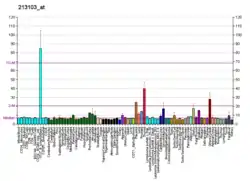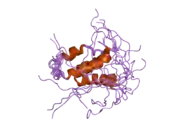| STARD13 | |||||||||||||||||||||||||||||||||||||||||||||||||||
|---|---|---|---|---|---|---|---|---|---|---|---|---|---|---|---|---|---|---|---|---|---|---|---|---|---|---|---|---|---|---|---|---|---|---|---|---|---|---|---|---|---|---|---|---|---|---|---|---|---|---|---|
 | |||||||||||||||||||||||||||||||||||||||||||||||||||
| |||||||||||||||||||||||||||||||||||||||||||||||||||
| Identifiers | |||||||||||||||||||||||||||||||||||||||||||||||||||
| Aliases | STARD13, ARHGAP37, DLC2, GT650, LINC00464, StAR related lipid transfer domain containing 13 | ||||||||||||||||||||||||||||||||||||||||||||||||||
| External IDs | OMIM: 609866 MGI: 2385331 HomoloGene: 64844 GeneCards: STARD13 | ||||||||||||||||||||||||||||||||||||||||||||||||||
| |||||||||||||||||||||||||||||||||||||||||||||||||||
| |||||||||||||||||||||||||||||||||||||||||||||||||||
| |||||||||||||||||||||||||||||||||||||||||||||||||||
| |||||||||||||||||||||||||||||||||||||||||||||||||||
| |||||||||||||||||||||||||||||||||||||||||||||||||||
| Wikidata | |||||||||||||||||||||||||||||||||||||||||||||||||||
| |||||||||||||||||||||||||||||||||||||||||||||||||||
StAR-related lipid transfer domain protein 13 (STARD13) also known as deleted in liver cancer 2 protein (DLC-2) is a protein that in humans is encoded by the STARD13 gene and a member of the DLC family of proteins.[5][6]
Function and structure
STARD13 serves as a Rho GTPase-activating protein (GAP), a type of protein that regulates members of the Rho family of GTPases.[7] It selectively activates RhoA and CDC42 and suppresses cell growth by inhibiting actin stress fiber assembly.[7]
The protein consists of an N-terminal sterile alpha motif (SAM) domain,[8] a serine-rich domain, a RhoGAP domain and at the C-terminus, a StAR-related lipid-transfer domain (START).
Tissue distribution and pathology
The protein was identified in part through its differential expression in cancers. A low level of STARD13 was observed in less differentiated hepatocellular carcinoma tissue with higher RhoA expression. A small patient study finds that the absence of STARD13 in hepatocellular carcinomas correlates with higher levels of RhoA and a poorer prognosis than patients with carcinomas that were STARD13-positive.[9]
References
- 1 2 3 GRCh38: Ensembl release 89: ENSG00000133121 - Ensembl, May 2017
- 1 2 3 GRCm38: Ensembl release 89: ENSMUSG00000016128 - Ensembl, May 2017
- ↑ "Human PubMed Reference:". National Center for Biotechnology Information, U.S. National Library of Medicine.
- ↑ "Mouse PubMed Reference:". National Center for Biotechnology Information, U.S. National Library of Medicine.
- ↑ Couch FJ, Rommens JM, Neuhausen SL, Bélanger C, Dumont M, Abel K, Bell R, Berry S, Bogden R, Cannon-Albright L, Farid L, Frye C, Hattier T, Janecki T, Jiang P, Kehrer R, Leblanc JF, McArthur-Morrison J, Meney D, Miki Y, Peng Y, Samson C, Schroeder M, Snyder SC, Simard J (August 1996). "Generation of an integrated transcription map of the BRCA2 region on chromosome 13q12-q13". Genomics. 36 (1): 86–99. doi:10.1006/geno.1996.0428. PMID 8812419.
- ↑ "Entrez Gene: STARD13 START domain containing 13".
- 1 2 Ching YP, Wong CM, Chan SF, Leung TH, Ng DC, Jin DY, Ng IO (March 2003). "Deleted in liver cancer (DLC) 2 encodes a RhoGAP protein with growth suppressor function and is underexpressed in hepatocellular carcinoma". The Journal of Biological Chemistry. 278 (12): 10824–30. doi:10.1074/jbc.M208310200. PMID 12531887.
- ↑ Li, Hongyan; Fung, King-Leung; Jin, Dong-Yan; Chung, Stephen S. M.; Ching, Yick-Pang; Ng, Irene Oi-lin; Sze, Kong-Hung; Ko, Ben C. B.; Sun, Hongzhe (2007-06-01). "Solution structures, dynamics, and lipid-binding of the sterile alpha-motif domain of the deleted in liver cancer 2". Proteins. 67 (4): 1154–1166. doi:10.1002/prot.21361. ISSN 1097-0134. PMID 17380510. S2CID 20407564.
- ↑ Xiaorong L, Wei W, Liyuan Q, Kaiyan Y (2008). "Underexpression of deleted in liver cancer 2 (DLC2) is associated with overexpression of RhoA and poor prognosis in hepatocellular carcinoma". BMC Cancer. 8: 205. doi:10.1186/1471-2407-8-205. PMC 2496915. PMID 18651974.
Further reading
- Ching YP, Wong CM, Chan SF, Leung TH, Ng DC, Jin DY, Ng IO (March 2003). "Deleted in liver cancer (DLC) 2 encodes a RhoGAP protein with growth suppressor function and is underexpressed in hepatocellular carcinoma". The Journal of Biological Chemistry. 278 (12): 10824–30. doi:10.1074/jbc.M208310200. PMID 12531887.
- Day CL, Puthalakath H, Skea G, Strasser A, Barsukov I, Lian LY, Huang DC, Hinds MG (February 2004). "Localization of dynein light chains 1 and 2 and their pro-apoptotic ligands". The Biochemical Journal. 377 (Pt 3): 597–605. doi:10.1042/BJ20031251. PMC 1223895. PMID 14561217.
- Nagaraja GM, Kandpal RP (January 2004). "Chromosome 13q12 encoded Rho GTPase activating protein suppresses growth of breast carcinoma cells, and yeast two-hybrid screen shows its interaction with several proteins". Biochemical and Biophysical Research Communications. 313 (3): 654–65. doi:10.1016/j.bbrc.2003.12.001. PMID 14697242.
- Colland F, Jacq X, Trouplin V, Mougin C, Groizeleau C, Hamburger A, Meil A, Wojcik J, Legrain P, Gauthier JM (July 2004). "Functional proteomics mapping of a human signaling pathway". Genome Research. 14 (7): 1324–32. doi:10.1101/gr.2334104. PMC 442148. PMID 15231748.
- Leung TH, Ching YP, Yam JW, Wong CM, Yau TO, Jin DY, Ng IO (October 2005). "Deleted in liver cancer 2 (DLC2) suppresses cell transformation by means of inhibition of RhoA activity". Proceedings of the National Academy of Sciences of the United States of America. 102 (42): 15207–12. Bibcode:2005PNAS..10215207L. doi:10.1073/pnas.0504501102. PMC 1250229. PMID 16217026.






